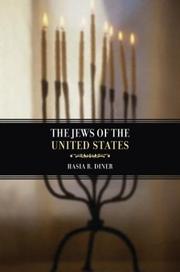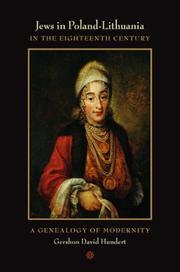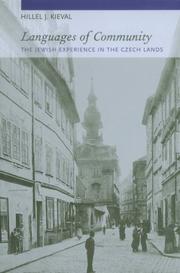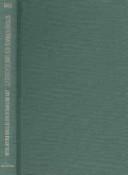| Listing 1 - 9 of 9 |
Sort by
|
Book
ISBN: 1479809063 1479850381 Year: 2017 Publisher: New York, NY : New York University Press,
Abstract | Keywords | Export | Availability | Bookmark
 Loading...
Loading...Choose an application
- Reference Manager
- EndNote
- RefWorks (Direct export to RefWorks)
The definitive history of Jews in New York and how they transformed the cityJewish New York reveals the multifaceted world of one of the city’s most important ethnic and religious groups. Jewish immigrants changed New York. They built its clothing industry and constructed huge swaths of apartment buildings. New York Jews helped to make the city the center of the nation’s publishing industry and shaped popular culture in music, theater, and the arts. With a strong sense of social justice, a dedication to civil rights and civil liberties, and a belief in the duty of government to provide social welfare for all its citizens, New York Jews influenced the city, state, and nation with a new wave of social activism.In turn, New York transformed Judaism and stimulated religious pluralism, Jewish denominationalism, and contemporary feminism. The city’s neighborhoods hosted unbelievably diverse types of Jews, from Communists to Hasidim. Jewish New York not only describes Jews’ many positive influences on New York, but also exposes their struggles with poverty and anti-Semitism. These injustices reinforced an exemplary commitment to remaking New York into a model multiethnic, multiracial, and multireligious world city. Based on the acclaimed multi-volume set City of Promises: A History of the Jews of New York winner of the National Jewish Book Council 2012 Everett Family Foundation Jewish Book of the Year Award, Jewish New York spans three centuries, tracing the earliest arrival of Jews in New Amsterdam to the recent immigration of Jews from the former Soviet Union.
Jews --- History. --- New York (N.Y.) --- Hasidim. --- Jewish Book of the Year Award. --- american jews. --- american zionism. --- anti-Semitism. --- bernie sanders. --- jewish experience. --- jewish immigrants. --- jewish neighborhoods. --- jews. --- new york history. --- new york neighborhoods. --- new york synagogues. --- orthodox jews. --- ruth bader ginsburg.
Book
ISBN: 9781479809066 1479809063 9781479850389 1479850381 Year: 2017 Publisher: New York, NY : New York University Press,
Abstract | Keywords | Export | Availability | Bookmark
 Loading...
Loading...Choose an application
- Reference Manager
- EndNote
- RefWorks (Direct export to RefWorks)
The definitive history of Jews in New York and how they transformed the cityJewish New York reveals the multifaceted world of one of the city’s most important ethnic and religious groups. Jewish immigrants changed New York. They built its clothing industry and constructed huge swaths of apartment buildings. New York Jews helped to make the city the center of the nation’s publishing industry and shaped popular culture in music, theater, and the arts. With a strong sense of social justice, a dedication to civil rights and civil liberties, and a belief in the duty of government to provide social welfare for all its citizens, New York Jews influenced the city, state, and nation with a new wave of social activism.In turn, New York transformed Judaism and stimulated religious pluralism, Jewish denominationalism, and contemporary feminism. The city’s neighborhoods hosted unbelievably diverse types of Jews, from Communists to Hasidim. Jewish New York not only describes Jews’ many positive influences on New York, but also exposes their struggles with poverty and anti-Semitism. These injustices reinforced an exemplary commitment to remaking New York into a model multiethnic, multiracial, and multireligious world city. Based on the acclaimed multi-volume set City of Promises: A History of the Jews of New York winner of the National Jewish Book Council 2012 Everett Family Foundation Jewish Book of the Year Award, Jewish New York spans three centuries, tracing the earliest arrival of Jews in New Amsterdam to the recent immigration of Jews from the former Soviet Union.
Jews --- History. --- New York (N.Y.) --- Hasidim. --- Jewish Book of the Year Award. --- american jews. --- american zionism. --- anti-Semitism. --- bernie sanders. --- jewish experience. --- jewish immigrants. --- jewish neighborhoods. --- jews. --- new york history. --- new york neighborhoods. --- new york synagogues. --- orthodox jews. --- ruth bader ginsburg.

ISBN: 1282358561 9786612358562 0520939921 1597346950 9780520939929 9781597346955 0520227735 9780520227736 1417545089 9781417545087 9781282358560 6612358564 0520248481 9780520248489 Year: 2004 Publisher: Berkeley University of California Press
Abstract | Keywords | Export | Availability | Bookmark
 Loading...
Loading...Choose an application
- Reference Manager
- EndNote
- RefWorks (Direct export to RefWorks)
Since Peter Stuyvesant greeted with enmity the first group of Jews to arrive on the docks of New Amsterdam in 1654, Jews have entwined their fate and fortunes with that of the United States-a project marked by great struggle and great promise. What this interconnected destiny has meant for American Jews and how it has defined their experience among the world's Jews is fully chronicled in this work, a comprehensive and finely nuanced history of Jews in the United States from 1654 through the end of the past century. Hasia R. Diner traces Jewish participation in American history-from the communities that sent formal letters of greeting to George Washington; to the three thousand Jewish men who fought for the Confederacy and the ten thousand who fought in the Union army; to the Jewish activists who devoted themselves to the labor movement and the civil rights movement. Diner portrays this history as a constant process of negotiation, undertaken by ordinary Jews who wanted at one and the same time to be Jews and full Americans. Accordingly, Diner draws on both American and Jewish sources to explain the chronology of American Jewish history, the structure of its communal institutions, and the inner dynamism that propelled it. Her work documents the major developments of American Judaism-he economic, social, cultural, and political activities of the Jews who immigrated to and settled in America, as well as their descendants-and shows how these grew out of both a Jewish and an American context. She also demonstrates how the equally compelling urges to maintain Jewishness and to assimilate gave American Jewry the particular character that it retains to this day in all its subtlety and complexity.
Jews --- History. --- United States --- Ethnic relations. --- History --- Ethnic relations --- american context. --- american history. --- american jewry. --- american jews. --- american judaism. --- antisemitism. --- civil rights movement. --- comparative religion. --- confederacy. --- cultural history. --- economic perspective. --- historiography. --- jewish communities. --- jewish culture. --- jewish experience. --- jewishness. --- judaism. --- labor movement. --- nonfiction. --- political activists. --- political acts. --- religion in america. --- religious historians. --- retrospective. --- social history. --- union army. --- united states. --- Jewish communities --- American Jews --- migration --- Jewish life in America --- Jewish politics --- 20th century --- Judaism

ISBN: 0520919297 0585178348 9780520919297 9780585178349 0520209249 0520209257 Year: 1998 Publisher: Berkeley University of California Press
Abstract | Keywords | Export | Availability | Bookmark
 Loading...
Loading...Choose an application
- Reference Manager
- EndNote
- RefWorks (Direct export to RefWorks)
The Jews of Modern France explores the endlessly complex encounter of France and its Jews from just before the Revolution to the eve of the twenty-first century. In the late eighteenth century, some forty thousand Jews lived in scattered communities on the peripheries of the French state, not considered French by others or by themselves. Two hundred years later, in 1989, France celebrated the anniversary of the Revolution with the largest, most vital Jewish population in western and central Europe. Paula Hyman looks closely at the period that began when France's Jews were offered citizenship during the Revolution. She shows how they and succeeding generations embraced the opportunities of integration and acculturation, redefined their identities, adapted their Judaism to the pragmatic and ideological demands of the time, and participated fully in French culture and politics. Within this same period, Jews in France fell victim to a secular political antisemitism that mocked the gains of emancipation, culminating first in the Dreyfus Affair and later in the murder of one-fourth of them in the Holocaust. Yet up to the present day, through successive waves of immigration, Jews have asserted the compatibility of their French identity with various versions of Jewish particularity, including Zionism. This remarkable view in microcosm of the modern Jewish experience will interest general readers and scholars alike.
Jews --- Middle East --- Regions & Countries - Asia & the Middle East --- History & Archaeology --- History --- Jewish religion --- History of France --- anno 1800-1999 --- France --- Ethnic relations. --- History. --- acculturation. --- alienation. --- antisemitism. --- assimilation. --- central europe. --- citizenship. --- discrimination. --- dreyfus affair. --- europe. --- france. --- french culture. --- french history. --- french identity. --- french jews. --- french revolution. --- global diasporas. --- hate. --- history. --- holocaust. --- integration. --- isolation. --- jewish citizenship. --- jewish experience. --- jewish particularity. --- jewish people. --- jewish population. --- jews. --- judaica. --- judaism. --- modern france. --- nonfiction. --- political antisemitism. --- prejudice. --- religion. --- zionism.
Book
ISBN: 1644691175 1644691302 1644691280 9781644691175 9781644691304 Year: 2019 Publisher: Academic Studies Press
Abstract | Keywords | Export | Availability | Bookmark
 Loading...
Loading...Choose an application
- Reference Manager
- EndNote
- RefWorks (Direct export to RefWorks)
This volume, while not the first to explore and critique the concept of Jewish identity, makes two important interventions into contemporary understandings of American Jewish life. It is the first collection to critically examine the relationship between Jewish education and Jewish identity. Insofar as Jewish identity has become the most popular way to talk about the desired outcome of Jewish education, a critical assessment of the relationship between education and identity is both useful and necessary. It is useful because the reification of identity has, we believe, hampered much educational creativity in the rather single-minded pursuit of this goal. It is necessary because the nearly ubiquitous employment of the term obscures a whole set of significant questions about what Jewish education is and ought to be for in the first place.Second, this volume offers responses that are not merely synonymous replacements for "identity." With a selection of more critical essays, we hope that we can begin to expand, rather than replace, the array of ideas that the term "identity" is so often used to represent.As scholars of Jewish education, the authors of this book hope their work contributes to any number of new conversations about the relationship between Jewish education and Jewish life. The intention here is to move from critical inquiry (in Part I of the volume) to suggestive possibilities (Part II). The true measure of this effort, of course, lies in the hands of the readers, those who will advance our understanding of the complexities of American Jewish education and life-beyond Jewish identity.
Jews --- Identity, Jewish --- Jewish identity --- Jewishness --- Jewish law --- Jewish nationalism --- Identity. --- Ethnic identity --- Race identity --- Legal status, laws, etc. --- American Jews. --- American Zionism. --- American post-Zionism. --- Jewish culture. --- Jewish education. --- Jewish experience. --- Jewish identity discourse. --- Jewish identity. --- Jewish learning. --- Jewish practices. --- Jewish studies. --- Judaism. --- Orthodox Judaism. --- community. --- contemporary Judaism. --- education. --- educational goals. --- educational research. --- identity discourse. --- identity politics. --- identity. --- liberal Judaism. --- multicultural. --- multiethnic Jews. --- performativity. --- religious identity. --- religious practice. --- semiotics. --- yeshiva.

ISBN: 1282358774 9786612358777 0520940326 1597346934 9780520940321 9780520238442 0520238443 9781282358775 9781597346931 0520238443 Year: 2004 Publisher: Berkeley University of California Press
Abstract | Keywords | Export | Availability | Bookmark
 Loading...
Loading...Choose an application
- Reference Manager
- EndNote
- RefWorks (Direct export to RefWorks)
Missing from most accounts of the modern history of Jews in Europe is the experience of what was once the largest Jewish community in the world-an oversight that Gershon David Hundert corrects in this history of Eastern European Jews in the eighteenth century. The experience of eighteenth-century Jews in the Polish-Lithuanian Commonwealth did not fit the pattern of integration and universalization-in short, of westernization-that historians tend to place at the origins of Jewish modernity. Hundert puts this experience, that of the majority of the Jewish people, at the center of his history. He focuses on the relations of Jews with the state and their role in the economy, and on more "internal" developments such as the popularization of the Kabbalah and the rise of Hasidism. Thus he describes the elements of Jewish experience that became the basis for a "core Jewish identity"-an identity that accompanied the majority of Jews into modernity.
Jews --- Mysticism --- Hasidism --- History --- Economic conditions --- Social conditions --- Judaism --- Poland --- Lithuania --- Ethnic relations. --- 18h century eastern european history. --- 18th century jewish history. --- 18th century jews. --- core jewish identity. --- demographic studies. --- east central europe. --- eastern european jews. --- european jews. --- hasidism. --- historical. --- history. --- integration. --- jewish community. --- jewish modernity. --- jewish. --- jews. --- judaism. --- kabbalah. --- minority communities. --- modernism. --- modernity. --- polish jewish experience. --- polish lithuanian commonwealth. --- polish state. --- political. --- politics. --- universalization. --- urban settlements. --- westernization.
Book
ISBN: 1283291843 9786613291844 0520949846 9780520949843 9780520259614 0520259610 0520274482 9780520274488 9781283291842 Year: 2012 Publisher: Berkeley University of California Press
Abstract | Keywords | Export | Availability | Bookmark
 Loading...
Loading...Choose an application
- Reference Manager
- EndNote
- RefWorks (Direct export to RefWorks)
"This book is a translation of historian Carlo Ginzburg's latest collection of essays. Through the detective work of uncovering a wide variety of stories or microhistories from fragments, Ginzburg takes on the bigger questions: How do we draw the line between truth and fiction? What is the relationship between history and memory? Stories range from medieval Europe, the inquisitional trial of a witch, seventeenth-century antiquarianism, and twentieth-century historians."--
Historiography --- Literature and history. --- History --- Truth. --- Collective memory. --- Philosophy. --- Errors, inventions, etc. --- academics. --- early modern europe. --- essay collection. --- europe. --- firsthand experience. --- historians. --- historical conventions. --- historical nonfiction. --- historical perspective. --- historical truth. --- historical. --- historiography. --- history. --- jewish experience. --- jewish studies. --- literary criticism. --- literary critics. --- memory. --- neoskepticism. --- nonfiction essays. --- philosophy. --- political. --- positivism. --- poststructuralism. --- retrospective. --- truth and fiction. --- writing history. --- Literature and history --- Truth --- Collective memory --- Philosophy --- Errors, inventions, etc

ISBN: 052092116X 1597347027 9780520921160 0585389829 9780585389820 9781597347020 9780520214101 0520214102 0520214102 Year: 2000 Publisher: Berkeley University of California Press
Abstract | Keywords | Export | Availability | Bookmark
 Loading...
Loading...Choose an application
- Reference Manager
- EndNote
- RefWorks (Direct export to RefWorks)
With a keen eye for revealing details, Hillel J. Kieval examines the contours and distinctive features of Jewish experience in the lands of Bohemia and Moravia (the present-day Czech Republic), from the late eighteenth to the late twentieth century. In the Czech lands, Kieval writes, Jews have felt the need constantly to define and articulate the nature of group identity, cultural loyalty, memory, and social cohesiveness, and the period of "modernizing" absolutism, which began in 1780, brought changes of enormous significance. From that time forward, new relationships with Gentile society and with the culture of the state blurred the traditional outlines of community and individual identity. Kieval navigates skillfully among histories and myths as well as demography, biography, culture, and politics, illuminating the maze of allegiances and alliances that have molded the Jewish experience during these 200 years.
Jews --- Identity, Jewish --- Jewish identity --- Jewishness --- Jewish law --- Jewish nationalism --- Hebrews --- Israelites --- Jewish people --- Jewry --- Judaic people --- Judaists --- Ethnology --- Religious adherents --- Semites --- Judaism --- Intellectual life --- Identity. --- Ethnic identity --- Race identity --- Legal status, laws, etc. --- Czech Republic --- Česká republika --- ČR --- Tschechische Republik --- Česko --- Czechia --- チェコ --- Cheko --- チェコ共和国 --- Cheko Kyōwakoku --- Tschechien --- Tschechenland --- Tschechei --- République tchèque --- República Checa --- Chequia --- Txèquia --- Txeca --- República Txeca --- Češka --- Czech Socialist Republic (Czechoslovakia) --- Czechoslovakia --- Ethnic relations. --- acculturation. --- antisemitism. --- ashkenazim. --- assimilation. --- belonging. --- bohemia. --- bohemian jewish. --- bohemian jewry. --- bohmen. --- bohmischen. --- central europe. --- community. --- culture. --- czech republic. --- czech. --- folk tale. --- folklore. --- gentiles. --- group identity. --- history. --- jan hus. --- jewish experience. --- jewish life. --- jewish. --- jews. --- judaica. --- judaism. --- kahal. --- language. --- linguistics. --- masaryk. --- memory. --- migration. --- moravia. --- myth. --- nationalism. --- nonfiction. --- place. --- prague. --- religion. --- religious pluralism. --- ritual murder. --- ritual. --- tradition. --- yiddish.

ISBN: 1281385581 0520937201 9786611385583 1597349283 9780520937208 1417508213 9781417508211 0520238427 9780520238428 0520238435 9780520238435 9781597349284 9781281385581 Year: 2004 Publisher: Berkeley University of California Press
Abstract | Keywords | Export | Availability | Bookmark
 Loading...
Loading...Choose an application
- Reference Manager
- EndNote
- RefWorks (Direct export to RefWorks)
In the 1990's, Vienna's Jews and queers abandoned their clandestine existence and emerged into the city's public sphere in unprecedented numbers. Symptoms of Modernity traces this development in the context of Central European history. Jews and homosexuals are signposts of an exclusionary process of nation-building. Cast in their modern roles in the late nineteenth century, they functioned as Others, allowing a national community to imagine itself as a site of ethnic and sexual purity. In Matti Bunzl's incisive historical and cultural analysis, the Holocaust appears as the catastrophic culmination of this violent project, an attempt to eradicate modernity's abject by-products from the body politic. As Symptoms of Modernity shows, though World War II brought an end to the genocidal persecution, the nation's exclusionary logic persisted, accounting for the ongoing marginalization of Jews and homosexuals. Not until the 1970's did individual Jews and queers begin to challenge the hegemonic subordination-a resistance that, by the 1990's, was joined by the state's attempts to ensure and affirm the continued presence of Jews and queers. Symptoms of Modernity gives an account of this radical cultural reversal, linking it to geopolitical transformations and to the supersession of the European nation-state by a postmodern polity.
Nationalism --- Gays --- Jews --- Consciousness, National --- Identity, National --- National consciousness --- National identity --- International relations --- Patriotism --- Political science --- Autonomy and independence movements --- Internationalism --- Political messianism --- Gay people --- Gay persons --- Homosexuals --- Persons --- Hebrews --- Israelites --- Jewish people --- Jewry --- Judaic people --- Judaists --- Ethnology --- Religious adherents --- Semites --- Judaism --- Social aspects --- Social conditions --- Austria --- Vienna (Austria) --- Wien (Austria) --- Vi︠e︡denʹ (Austria) --- Vedenʹ (Austria) --- Vena (Austria) --- Wiedëń (Austria) --- Bécs (Austria) --- Vindobona (Austria) --- Videnʹ (Austria) --- Vienne (Austria) --- Viena (Austria) --- Wienn (Austria) --- Dunaj (Austria) --- Wean (Austria) --- Wenen (Austria) --- Wina (Austria) --- Wene (Austria) --- Uigenna (Austria) --- فيينا (Austria) --- Fīyinnā (Austria) --- Vyana (Austria) --- Вена (Austria) --- Горад Вена (Austria) --- Виена (Austria) --- Beč (Austria) --- Fienna (Austria) --- Viin (Austria) --- Βιέννη (Austria) --- Вена ош (Austria) --- Vena osh (Austria) --- Vieno (Austria) --- Viene (Austria) --- Vín (Austria) --- Veen (Austria) --- 빈 (Austria) --- Венæ (Austria) --- Venæ (Austria) --- וינה (Austria) --- Ṿinah (Austria) --- Vienna (Reichsgau) --- Social policy. --- History --- Social life and customs --- Ethnic relations. --- #SBIB:39A6 --- #SBIB:39A72 --- #SBIB:613.88H31 --- Etniciteit / Migratiebeleid en -problemen --- Etnografie: Europa --- Homoseksualiteit, biseksualiteit --- Juifs --- Homosexuels --- Nationalisme --- Conditions sociales --- Vienne (Autriche) --- Autriche --- Relations interethniques --- Moeurs et coutumes --- Histoire --- Politique sociale --- Jews -- Austria -- Vienna -- Social conditions -- 20th century.. --- Gays -- Austria -- Vienna -- Social conditions -- 20th century.. --- Nationalism -- Social aspects -- Austria.. --- Vienna (Austria) -- Ethnic relations.. --- Vienna (Austria) -- Social life and customs -- 20th century.. --- Austria -- History -- 1955-. --- Austria -- Social policy. --- 1990s. --- austria. --- central europe. --- cultural history. --- emancipation. --- ethnic issues. --- european history. --- geopolitical change. --- historians. --- historiography. --- history of sexuality. --- holocaust. --- jewish experience. --- judaism. --- late 20th century. --- lgbtq. --- marginalization. --- modern history. --- modernity. --- nation building. --- persecution. --- political history. --- postmodern analysis. --- public sphere. --- queer history. --- retrospective. --- sexual politics. --- vienna. --- viennese homosexuals. --- viennese jews. --- world war ii. --- wwii.
| Listing 1 - 9 of 9 |
Sort by
|

 Search
Search Feedback
Feedback About UniCat
About UniCat  Help
Help News
News